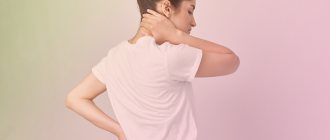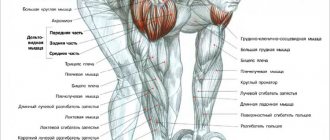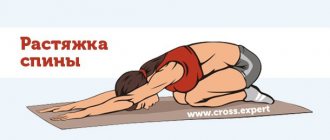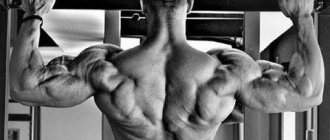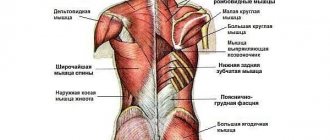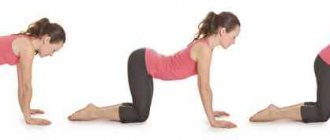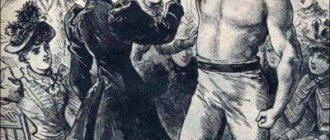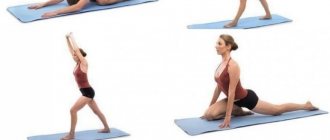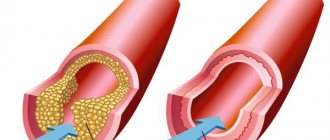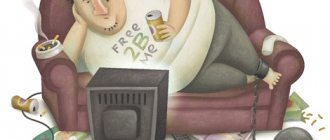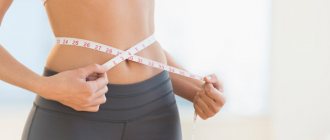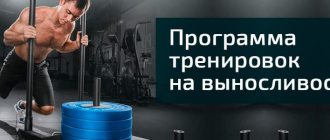Slouching is one of the most common problems of the twenty-first century. A sedentary lifestyle and bad habits have a detrimental effect not only on the beauty of the back, but also on the health of the entire musculoskeletal system as a whole. To prevent curvature of the spine in the future, it is necessary to overcome the bad habit of hunching your back in time, and an orthopedic posture corrector will help to do this, as well as a set of special exercises, which will be discussed further in our article.
The muscular corset of the back includes a special rhomboid muscle, which tends to weaken. If you do not train it and do not maintain its tone, over time this can cause stooping. In other words, it is the rhomboid muscle that ensures beautiful and even posture, and if this part of the back is weakened, disturbances in the anatomical position of the spinal column appear. An orthopedic corset for posture correction will help correct this situation, as well as performing a set of exercises to strengthen the muscular frame of the back - Andrey Beloveshkin, Candidate of Medical Sciences, anesthesiologist-reanimatologist.
Summary:
- What is stoop?
- Causes of stooped back in children
- Causes of stooped back in adults
- How to fix slouching in 14 days?
- A set of exercises against stooping
- What is the difference between stoop and kyphosis?
- Is it possible to get rid of stooping at home?
- Does a corset help eliminate stooping? Classification of corsets
- Application of a corset
What muscles work
It is important to perform the exercise correctly to get the maximum results from your training.
When performing the “Chair” exercise against the wall correctly, the following muscles are involved:
- front of the thighs (quadriceps);
- upper and lower back;
- press;
- gluteal;
- calf;
- hands
What is stoop?
Slouching is a back deformity that occurs due to weak muscles and disorders of the musculoskeletal system.
Our back is penetrated by a huge number of muscles - they are divided into deep (they help keep the back in an upright position and provide body movement) and superficial (responsible for the beautiful relief on the body, smooth movement and are involved in breathing).
Pinched and displaced muscles affect the functioning of the respiratory system, eyes, gastrointestinal tract, heart and blood vessels.
Forms of kyphosis curvature
Pathological kyphosis can be:
- congenital;
- acquired.
By severity:
- mild (1st degree) – the angle of curvature of the spine does not exceed 40 degrees;
- moderate (2nd degree) – curvature angle 40-60 degrees;
- severe (3rd, 4th degree) – curvature angle over 60-71 degrees.
According to the degree of resistance to deformation:
- fixed, not amenable to correction;
- mobile, corrected in the supine position, corrected with the help of conservative or surgical treatment.
With the flow:
- progressive, depending on the change in the angle of convexity over the year, progression can be slow or rapidly developing;
- not progressive.
By form:
- angular in the form of a hump with an apex of 1-2 spinous vertebrae;
- arched in the shape of an elongated short arc.
Congenital deformity
Congenital kyphotic deformities are caused by developmental anomalies of the anterior parts of the spine - wedge-shaped or half-vertebrae in the thoracic region, fusion (concrescence) of the vertebral bodies due to intrauterine developmental disorders of the fetus.
Genotypic kyphosis is hereditary and is transmitted from generation to generation according to a dominant trait.
Acquired forms of curvature
Acquired deformities are caused by poor posture, injuries, diseases of the musculoskeletal system, and bone tissue.
The following types of acquired kyphosis are distinguished:
- Postural (postural) or functional, which is also called a round back, develops in adolescents and people under 30 years of age, more often than not in girls and women, as a result of constant stooping with weakness of the muscles that support body position.
- Juvenile kyphosis in Scheuermann-Mau disease develops during the period of active growth of the child, most often in adolescence in boys. It is characterized by progressive kyphotic deformation of the thoracic spine with compaction of the affected vertebrae. With Calvet disease, the height of one or more vertebrae is significantly less than the others, which leads to a wedge-shaped deformity of the spinal column. Most often, this disease is diagnosed in boys 7-15 years old.
- Paralytic hump develops against the background of diseases that cause muscle paralysis - cerebral palsy, polio, muscular dystrophy.
- Rickets manifests itself in infancy or in older children who suffered rickets at an early age. Due to soft bone tissue and muscle weakness, the vertebrae change shape and become displaced.
- Post-traumatic deformity occurs after spinal injuries - compression and comminuted fractures, displacements, unsuccessful stabilization of the vertebrae after surgery.
- Degenerative kyphosis develops as a result of diseases leading to degenerative-dystrophic changes in the anatomical structures of the spine - osteochondrosis, spondyloarthrosis, spondylosis.
- The senile hump develops and progresses after 60-70 years, mainly in women due to pathological dystrophic changes in the intervertebral discs of osteoporotic vertebrae, changing position, degenerating and sprouting connective tissue.
- Tuberculous spondylitis causes the development of kyphosis with deformation in the form of a pronounced pointed hump.
- In the later stages of ankylosing spondylitis, the back forms a continuous arc from the beginning of the neck to the sacrum.
Causes of stooped back in children
We come into this world with an absolutely straight spinal column. In the second or third month of life, the first curve appears - cervical lordosis. This happens at the moment when the baby can hold his head up on his own. After another three to four months, a second curve appears - thoracic kyphosis. This is the moment when the child is already sitting independently. At ten to twelve months, when a little person takes his first steps, another curve appears - lumbar lordosis. But only by the age of seven does the formation of all curves end. We wrote more about child posture here.
So why does a child begin to slouch? Here are several possible reasons:
- Excessive physical activity or lack thereof;
- Flat feet and other foot deformities;
- Spinal injuries;
- Psychological complexes (the child tries to “hide” from the outside world and slouches because of this);
- Hereditary joint flexibility;
- Scoliosis, osteochondrosis, kyphosis and other types of spinal curvature.
Treatment and prevention
It should be understood that incompetent intervention in the treatment of a hump on the back can be fraught with even greater complications. Therefore, consultation with a specialist when choosing a treatment method is mandatory. Depending on the type, degree of development and neglect of the disease, different types of therapy may be prescribed.
This is important to know: What harm does incorrect posture cause to the body?
- Therapeutic and recreational physical education. The practice of adequate physical activity allows you to strengthen the muscular corset, form a stereotype of correct body position, and return the physiological natural state of the spinal column. With regular implementation of the prescribed set of exercises, significant improvements are observed in the patient's condition. The intensity of physical activity and specific exercises are prescribed to each patient individually. In difficult cases, observing the training of a specialist who tells you what to do and how is highly desirable.
- Physiotherapeutic methods involve improving and restoring the sensitivity of nerve endings. Physiotherapy can be prescribed: magnetotherapy, paraffin therapy, mud therapy, ultrasound, electrical muscle stimulation, heat therapy. The procedures chosen for treatment help restore muscle tone, improve blood circulation, and restore normal metabolism.
- Manual therapy involves mechanical action on the position of the vertebrae, returning them to the correct position. A chiropractor is a high-class specialist, knows anatomy perfectly and has intuition, on which successful treatment depends. You should make sure whether you can trust a chiropractor, since inept manipulation of the spinal column can lead to unpredictable and irreversible consequences. It is better to choose a specialist by recommendation. Usually a repeat session is scheduled after three days, the number of sessions is determined individually.
- Massage is prescribed as an independent or accompanying manual therapy procedure. Thanks to a course of massage, muscle tone increases, tension is eliminated, restoration of normal blood flow helps to normalize metabolic processes and, as a result, revitalize tissue, slow down the destruction of intervertebral discs and the overall progress of the disease.
- Orthotics is the use of auxiliary orthopedic devices (corsets) to restore the lost ability to correct posture. In each individual case, the device is selected individually.
- Swimming is prescribed to patients with back problems under the supervision of a trainer. Regular exercises restore the ability to breathe properly, strengthen the spinal muscles, help eliminate spinal deformities, and make posture normal.
Causes of stooped back in adults
Although posture is mainly formed in childhood, at a later age situations can also arise that lead to stooping:
- A sedentary lifestyle (and almost everyone is guilty of this now) or vice versa - too active work associated with lifting weights (in this case, a special bandage will help you);
- Muscle imbalance (can be caused by lack of activity);
- Psychological factor (the same complexes or stressful situations);
- Injuries and diseases of the spine (in these cases, consultation with a doctor is required. Do not self-medicate!);
- Pregnancy (during this period, the female body changes a lot. A bandage can also help here, so that it is easier for the back to bear the load. But even after the birth of the baby, do not forget to monitor the posture.
- Wrong mattress and pillow (and sleeping position);
- Carrying a bag or backpack on one shoulder (the heavier the load, the stronger the curvature).
Is poor posture a disease?
Different gaits//Illustration by: Studioworkstock, Shutterstock
Stooping is not a disease, but a habit of being in a position that is comfortable for yourself, but uncomfortable for your body.
Other habits can be identified by poor posture. For example, a pose in which a person leans his chest forward while standing is called the “Donald Duck pose.” It is formed by frequent wearing of heels or by obesity, when excess weight accumulates mainly on the stomach. When the center of gravity shifts, it is more convenient to pull the body forward.
Among office workers and everyone who spends a lot of time sitting, a certain posture is common: the head is lowered, the back does not bend in the lower back, but is rounded. It’s as if it’s hard for a person to stand, let alone straighten up.
Unlike stoop, scoliosis is a disease that is included in the group of deforming dorsopathies. This is a separate large category in ICD-10 (a single database of diseases for doctors around the world).
In fact, scoliosis is a rare disease with no known cause. This diagnosis is given to 3% of patients in the United States. In Russia there are no exact statistical data, because in the Soviet Union any deviation of the spine from the normal axis was secretly called scoliosis. But this is not true.
With scoliosis, not only posture is affected, but also the stability of the entire spine - the vertebrae twist and rotate relative to each other. This is another important criterion and is determined using radiography, MRI and CT.
⚡More useful materials
Help: I sweat a lot and it interferes with my life
The best way to protect yourself: a guide to modern contraception
Convenient and environmentally friendly: how to replace disposable pads and tampons
How to fix slouching in 14 days?
It is almost impossible to completely solve the problem in 2 weeks. Think for yourself: you haven’t paid attention to the health of your back for so long and you’ve been harming it. In addition, it is much more difficult for adults to work on their posture. But anything is possible! In two weeks, of course, you will not achieve royal posture, but in a month this is more than realistic. Well, the first results will be noticeable within 14 days.
Of course, this is difficult to do on your own. Therefore, we recommend that you sign up for the Basic Marathon “BoldlyNET”. Hundreds of women have already achieved amazing results. Be one of them!
A set of exercises against stooping
- Roller:
- Place the ball under the shoulder, at the base of the neck. We choose the point where it hurts the most;
Press your body onto the ball. It can be very painful, so we choose a pressure that we can tolerate;
- Turn your head away from your shoulder. This creates additional stress;
- The first time we stand for 15-20 seconds. Each time you need to increase the time.
- Shoulder and neck relaxation exercise;
- Place the ball under the shoulder, at the base of the neck. We choose the point where it hurts the most;
Press your body onto the ball. It can be very painful, so we choose a pressure that we can tolerate;
- Turn your head away from your shoulder. This creates additional stress;
- The first time we stand for 15-20 seconds. Each time you need to increase the time.
- Relaxing the back of the neck
- We place our hands on the back of the neck;
Massage your neck with your thumbs in a circular motion;
- We walk over the entire surface;
- If desired, you can add an additional movement - rhythmically rocking the head towards the massage movements.
- Fighting computer neck
- We clasp our hands behind our backs and move them back as much as possible, and stretch our heads forward;
We change position - arms forward and head back;
- We don’t sit down to work until we do this exercise!
- Getting rid of a hump on the neck
- Hands clasped behind your back, raise them up;
We tilt our head back, placing the back of the head on the mound and, as it were, squeezing it out;
- Hold the position for at least 15 seconds;
- At the end, rub the hump with dense movements - one hand to the hair, the other down.
- Ball exercise
- We take a ball, a little larger than a tennis ball (at the very beginning, working with a tennis ball will be painful and uncomfortable);
We place this ball between the neck and the wall;
- Pressing the ball, we roll it all over the neck. We work out pain points especially carefully;
- We work for 3-5 minutes.
- We put the shoulder blades
- The simplest exercise you should do every morning. On the way to the bathroom, we freeze at any doorway;
We place our feet at the same level with the door, hold the doorframe with our hands and sag our body forward;
- The pelvis should not hang, the shoulder blades should be brought together; hang for 30 seconds and then round your back, hugging yourself deeply with your arms;
- We repeat the exercise throughout the day.
What is the difference between stoop and kyphosis?
Kyphosis is a type of postural disorder. It can be congenital or acquired. It manifests itself in too much bending in the thoracic or sacral region. The first one is more common.
Kyphosis occurs due to:
- spinal deformities or injuries;
- bad heredity;
- muscle weakness;
- some diseases.
And just stooping is one of the main signs of thoracic kyphosis. In this case, the person's shoulders are lowered and tilted forward, as is the entire upper body.
If you do not start to deal with this problem in time, then hunchback may develop. In the initial stages, kyphosis can be cured with special gymnastics, but the more advanced the case, the more methods are used. This can be massage, physical therapy, manual and osteopathic practices, physiotherapy and even surgery. But it’s better not to go to extremes and start doing the exercises right now.
Surgical intervention
This is the fastest way to get rid of growth. It is based on liposuction - through small incisions on the skin, fat is suctioned using a vacuum.
Surgeons use several methods to remove fat: using ultrasound, standard cutting, laser or tumescent surgery. The latter is carried out by injecting a special drug into the affected area, which liquefies the fat, making it easier to remove.
Ultrasound surgery involves the destruction of fat cell membranes; it is quick and painless. Laser surgery is considered the most effective method - it is performed without puncturing the skin, but lipids are destroyed.
Is it possible to get rid of stooping at home?
Yes, of course you can return your spine to a healthy state at home. But first understand what condition he is in. To do this you need to do a small test:
- Lean your heels, sacrum and shoulder blades against the wall.
- Place your palm between the wall and your lower back - with correct posture, it should fit there comfortably. But if there are deviations, then it either will not pass this distance at all, or only the fingers will pass.
- Now feel your shoulder blades. Normally they should be pressed against the wall. Otherwise, the stronger the deviation, the stronger the violation.
- At the end we look at the head. The back of your head should also be pressed against the wall. If you have problems with your posture, then it can shift forward (and quite strongly).
Well, how many deviations from the norm do you have? Spoiler: the more there are, the worse the situation.
So what you can do first is:
- First of all, take care of your sleeping place. Buy an orthopedic pillow and mattress. This will not only help you get rid of slouching, but also improve the quality of your sleep.
- But the mattress is only half the job. It is also important to sleep on it correctly. And this needs to be done lying either on your back or on your side (but in this case you need to put a pillow between your knees).
- You need to stand on two legs. Do not transfer weight from one limb to another; the weight should be distributed evenly.
- When sitting, do not cross your legs. This interferes with blood circulation and leads to swelling.
- While walking, do not lean your body forward.
Exercising in the pool is very helpful for stooping. Only in water can our body relax completely. In addition, there the muscles are pumped evenly and without unnecessary tension. And this is the safest sport.
And again about the roller. Well, yes, we love him very much and are trying to teach you this. Just 5 minutes a day and after 2-3 weeks of regular exercise you will notice the first results - your back will hurt less, stiffness and tension will disappear. Pay attention to the miracle roller with lavender from Beauty365. It will not only evenly distribute the load on the entire spine, but will also help you relax due to the soothing scent of the plant.
Does a corset help eliminate stooping?
Some people despair and stop believing in their own abilities in the fight against stoop and resort to the help of additional devices. And most often these are corsets.
On the one hand, they really achieve the correct curves of the back, but at the same time they atrophy the already “lazy” muscles. This happens because the supporting structure works instead of the muscles and they, in turn, understand that they can no longer perform their function. What for? They are already doing it for them. As a result, when you take off the corset, it becomes even more difficult to hold your back correctly. Hello, even more severe curvature!
Classification of corsets
Corsets are divided into several groups.
By functional value:
- Fixing - used during injuries. They fix the affected part and prevent the vertebrae from moving from their place;
- Corrective - used for stooping to correct the spine.
By degree of hardness:
- Elastic - made from elastic bandages without rigid inserts. Used for subtle postural disorders;
- Hard - used for severe curvatures and during rehabilitation after injuries. These corsets have special rigid plates sewn into them, which are located parallel to each other on the sides of the spine.
By fixation area (the name makes it clear which areas they support):
- Thoracolumbar;
- Lumbosacral;
- Lumbar.
Application of a corset
The corset is attached either to the naked body or to cotton underwear. The person should stand up straight, spread his shoulders and raise his head.
Elastic bands are thrown forward over the shoulders, and then passed through the armpits and fixed crosswise on the back. Only after this the degree of fixation of the corset is adjusted using Velcro, which is located in the abdomen area.
Children are sent to school with such corsets, and adults go to work. It can make breathing difficult, prevent a person from moving fully, and in the summer it rubs due to the heat. And although manufacturers recommend wearing it no more than 6 hours, it is not always possible to remove the device on time. Then the harm will increase. As a result, instead of beautiful posture, you get weakened muscles and a complete lack of strength in your back.
Don't torture yourself with a corset. Better sign up for the updated basic marathon “BoldlyNET”. There we pay special attention to the back and treat stoop with a special set of exercises. Participants notice that after 14 days the first results appear. Moreover, the classes will take only 5-35 minutes, and you can access them at any time.
Massage
Many people think that they can correct their posture with massage, but this is a wrong opinion. Massage can strengthen the back muscles that support the spine, increase their elasticity, and eliminate muscle spasms. Massage also has a positive effect on blood and lymph circulation in the vessels, ensuring the prevention of osteochondrosis and pain in the back, neck and lower back. The massage must be performed by a specialist with a medical education and license.
Massotherapy
If it is not possible to undergo a professional massage course, you can use special back massagers. You can also perform stroking, rubbing and pinching with a rough washcloth in the form of a mitten, which is put on your hand. The duration of the massage should be about 5-7 minutes. It is better if a person takes a hot shower or bath before this.
Back and neck massager
Note! A contrast shower (alternating hot and cold dousing) also increases the tone of the spinal muscles and promotes gradual correction of posture. The procedure should always be completed with a cool douche. If a person has never hardened before, hardening should begin with cool foot baths: only after this can one proceed to dousing the entire body.
Back and neck massager
